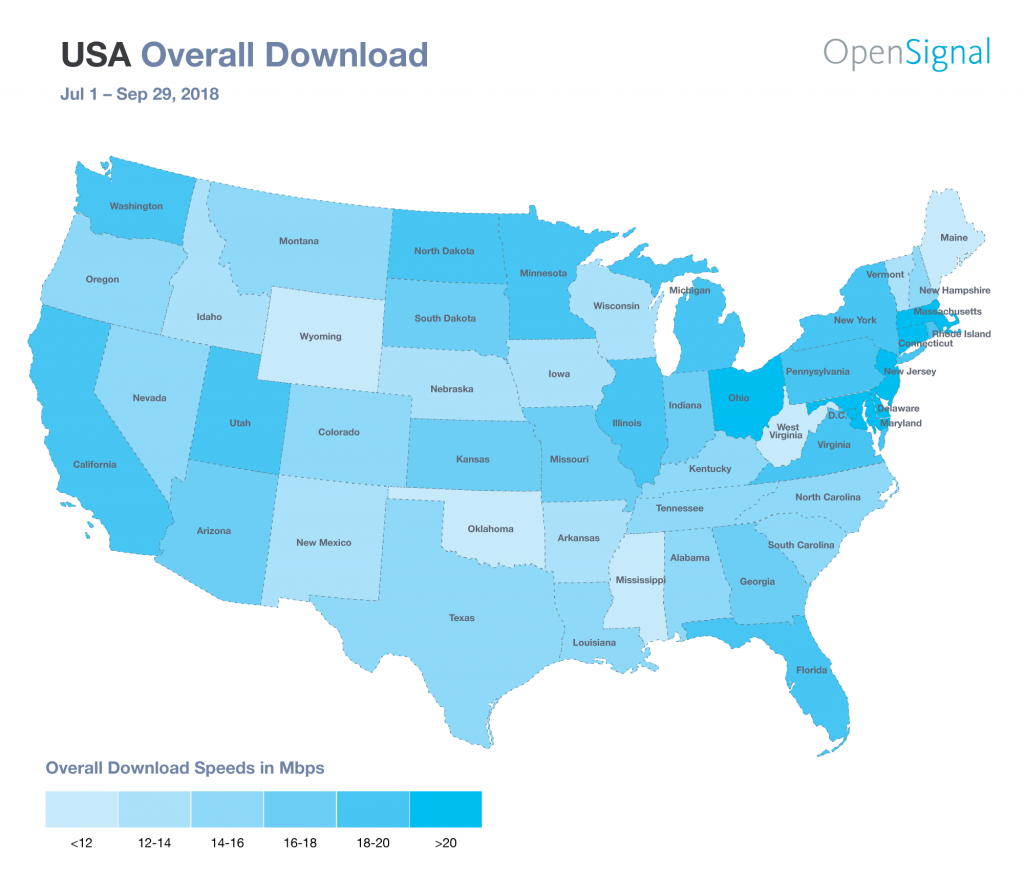Only one state or commonwealth can claim to have the fastest mobile broadband speeds in the union, and that state is New Jersey. In OpenSignal's analysis of the lower 48, we found that the Garden State outperformed its peers in both our overall speed metrics, with an average download connection of 24.1 Mbps and an average upload connection of 7.1 Mbps.
Technically the District of Columbia had a faster overall upload speed with a score of 8.1 Mbps, but D.C. isn't actually a state and it's a heck of a lot easier to provide consistently fast speeds in a single large city than it is across an entire state. So we're giving New Jersey the win. If you have a problem with that, email your Congressman (he or she should have excellent mobile internet access).

What makes New Jersey so special? Being the home of the country's largest operator Verizon probably doesn't hurt, but in our download analysis we found that New Jersey sits smack dab in the middle of a nexus of speedy states in the U.S. The fastest average overall download speeds we recorded in the U.S. were concentrated on the Eastern Seaboard, centered on the Mid-Atlantic but ranging from lower New England to Virginia. Of the top 10 overall download speed scores we recorded in the lower 48, eight of them were in that band (including D.C.). And with the exception of Ohio, every state with average overall download more than 20 Mbps fell within that zone.

What those states have in common is very dense populations. The Boston-to-Washington corridor is home to more than 50 million people and contains some of the largest cities in the U.S. Operators tend to focus their network and capacity upgrades on urban areas first, which explains why we're seeing some of the fastest speeds on the Eastern Seaboard as well as other highly populated areas like California, Florida, Washington and the big states of the Midwest. What's more, in our East Coast "fast zone" most of the cities and suburbs are situated closely to one another, leaving few rural areas in between. It's much easier for an operator to provide consistent LTE access in a geographically urbanized state, than a state with large swathes of rural areas in between population centers.
The states that did poorly in overall download speed rankings therefore tended to be more rural states without any major urban population center. Maine, Mississippi, Oklahoma, West Virginia and Wyoming all had overall download averages less than 12 Mbps. But rural wasn't always an indicator of slower speeds. For instance, the Dakotas performed well in download speed, in particular North Dakota, which came in 12th in our rankings.

In our upload analysis, our speed nexus of states largely disappeared and we saw a more even distribution of overall speeds across the country. New Jersey was still the top state on the list, and it did particularly well, establishing a healthy 600 kbps lead over its closest rival. But the rest of our top 10 included only three other East Coast states, making room for Illinois, Ohio and both Dakotas.

The distribution of upload speeds wasn't completely random though. Most of the top 24 states in overall download speed also wound up in the top 24 of our overall upload speed chart — just in a differing order. That makes sense from a technical perspective, as upload capacity on a network usually increases with download capacity (though there are a few exceptions as we've seen with Sprint's LTE networks). The reason we're not seeing a much closer correlation between the fastest download and upload scores in our analysis may be because different states may be using their capacity in different ways. On the download side of the network, there's a pretty clear killer application, mobile video, which accounts for the vast majority of data traffic on U.S. networks today. But for upload, use cases are much more varied. Upload is key for social media and file sharing, video chat and other real-time communications apps and even live gaming. The differing demographics in different states along with the types of applications those demographics use could produce varying demands for upload capacity, which in turn could impact speeds.
If you're a mobile consumer in the lower 48, we'd love to hear about your own download and upload speed experiences in your home state. Tell us about them in comments section below or on Twitter.
Opensignal Limited retains ownership of this insight including all intellectual property rights, data, content, graphs & analysis. Reports and insights produced by Opensignal Limited may not be quoted, reproduced, distributed, published for any commercial purpose (including use in advertisements or other promotional content) without prior written consent. Journalists are encouraged to quote information included in Opensignal reports and insights provided they include clear source attribution. For more information, contact [email protected].
